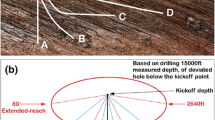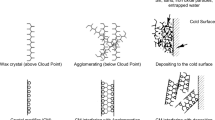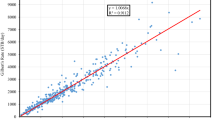The composite casing drilling technology in a deep-water riserless well construction is the technology providing drilling of the tandem borehole composed of the surface conductor borehole and the surface casing borehole in a one-trip drilling operation. The composite casing is put into place and is cemented in one trip. The composite casing drilling technology not only combines the advantages of the drilling method and the jetting technology but also overcomes the limitations of both technologies. The composite casing drilling technology has been successfully applied in the Mozambique block A drilling projects. The results of the field application show that this technology is able to provide secure and efficient drilling operations, which can considerably reduce the installation time and the costs. In this paper, based on the example of application in the Mozambique block A gas field, the process of the composite casing drilling technology is described in detail. Then, the authors analyze the field conditions and put forward an optimization method. The optimization method is applied to select the optimal technology for drilling and installing the surface conductor and the surface casing.





Similar content being viewed by others
References
M. Russo et al., “Integrity assessment of offshore subsea wells: evaluation of wellhead finite element model against monitoring data using different soil models,” J. Offshore Mech. Arct. Eng., 138(6), 061301-061317 (2016).
K. Su, S. Butt, J. Yang, et al., “Coupled dynamic analysis for the riser-conductor of deepwater surface BOP drilling system,” Shock Vibr., 2018, 1-15 (2018).
K. Su, Z. Guan, and Z. Long, “Impact of the seabed soil properties on the stability of subsea wellhead for deepwater drilling,” Oil Drill. Prod. Technol., 34(3), 7-10 (2012).
K. Su, J. Yang, and S. Butt, “An innovative device to enhance conductor bearing capacity in deepwater drilling operations,” J. Offshore Mech. Arct. Eng., 140(1), 4037830 (2018).
Q. Yin, J. Yang, H. Xiu, et al., “Material qualification of a 13Cr-L80 casing for sour conditions,” Mater. Test., 61(9), 833-841 (2019).
R. Wiśniowski, “New drilling methods for the conductor casing operations,” Acta Montan. Slovac., 11(1), 242-246 (2006).
W. Li et al., “Subsea wellhead stability study of composite casing for deepwater drilling,” Ocean Eng., 214, 107780 (2020).
J. Yang and D. Gao, “Technologies for inspecting and predicting formation pressure while drilling,” J. Univ. Pet. (Chin.), 1999 (1999).
Q. Yin, J. Yang, M. Tyagi, et al., “Field data analysis and risk assessment of gas kick during industrial deepwater drilling process based on supervised learning algorithm,” Proc. Saf. Environ. Prot., 146(1), 312-328 (2021).
J. Yang and S. Peng, “Experimental research on interaction of pile with soil under condition of pile group,” Rock Soil Mech., 02, 312-315 (2004).
J. Yang and S. Cao, “Current situation and developing trend of petroleum drilling technologies in deep water,” Oil Drill. Prod. Technol., 02, 10-13(2008).
J. Yang et al., “Research on prediction model for formation pressure in compression structure,” Acta Pet. Sin., 30(5), 764-768 (2009).
B. Zhou et al., “A jetting flow rate design method for conductor installation through jetting in deepwater drilling,” Pet. Drill. Techniq., 44(3), 21-26 (2016).
C. Kan et al., “Load bearing characteristics study on novel deepwater composite drilling conductor by simulation and experimental methods,” J. Pet. Sci. Eng., 171, 289-301 (2018).
R. D. Beck et al., “Reliable deepwater structural casing installation using controlled jetting,” SPE Annual Technical Conference and Exhibition, Dallas, Texas (1991).
P. Jeanjean, “Innovative design method for deepwater surface casings,” SPE Annual Technical Conference and Exhibition, San Antonio, Texas (2002).
L. F. Eaton et al., “Deepwater batchset operations through the Magnolia shallow water flow sand. “ SPE/IADC Drilling Conference, Amsterdam, Netherlands (2005).
T. J. Akers, “Jetting of structural casing in deepwater environments: job design and operational practices,” SPE Drill. Complet., 23(1), 29-40 (2008).
J. Yang et al., “Bit stick-out calculation for the deepwater conductor jetting technique,” Pet. Explor. Devel., 40(3), 394-397(2013).
C. Kan et al., “Field experimental investigation of bit stick-out for different soil strengths during deepwater conductor injection,” J. Pet. Sci. Eng., 169, 825-836 (2018).
L. Wang et al., “Optimal design of hydraulic parameters for conductor jetting in deepwater drilling,” Pet. Drill. Techniq., 43(2), 19-24 (2015).
Acknowledgments
This study has been performed with the support of the following projects.
Fund number: 2021DJ2506 Project of the China National Petroleum Corporation “Key Engineering Technology of Ultra-deepwater Drilling in Oversea Projects.”
Fund number: 2021-168 Project of the China National Oil and Gas Exploration and Development Company “Research on Drilling Difficulties and Drilling Engineering Design of Overseas Key Exploration Wells.”
Author information
Authors and Affiliations
Corresponding author
Additional information
Translated from Khimiya i Tekhnologiya Topliv i Masel, No. 1, pp. 114–119 January – February, 2022.
Rights and permissions
About this article
Cite this article
Wang, G., Li, W., Long, Y. et al. Technological Process of the Composite Casing Drilling Technology in Deep-Water Riserless well Construction. Chem Technol Fuels Oils 58, 95–103 (2022). https://doi.org/10.1007/s10553-022-01356-w
Published:
Issue Date:
DOI: https://doi.org/10.1007/s10553-022-01356-w




